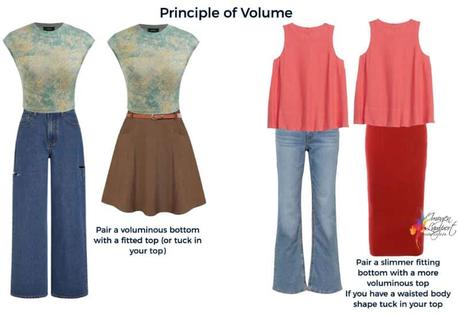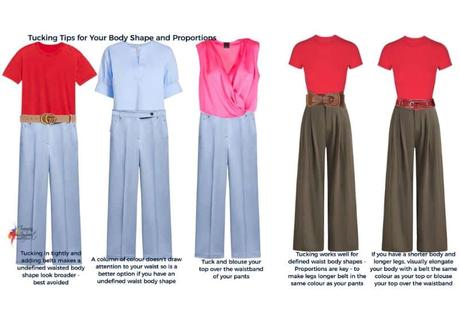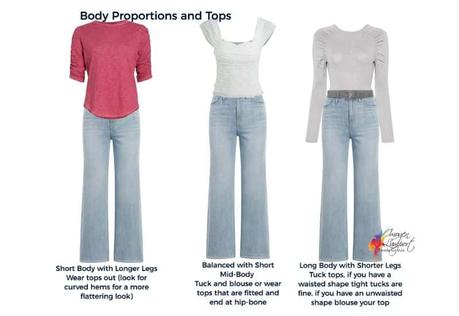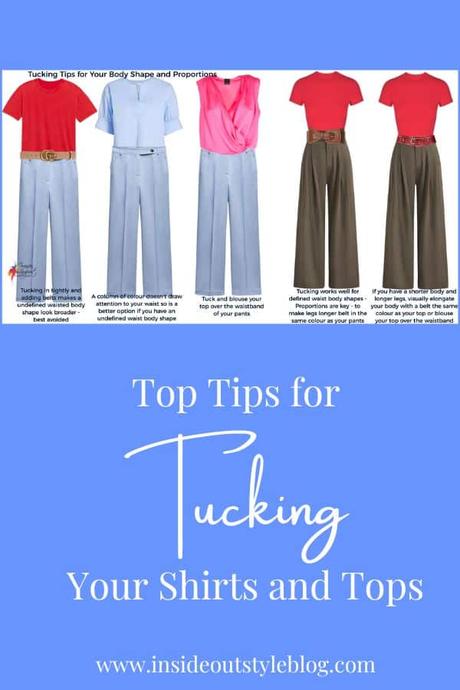One of the hot topics that came up in my 7 Steps to Style program members' Zoom session this month was all about tucking tops.
Why is it suddenly feeling like an issue?
Well, it's because styles of pants have changed which means that what may have worked before isn't working as well now. As the fashion pendulum has swung from skinny and slim jeans and pants to wider and looser leg pants we've gone from wearing longer and looser tops and jackets to needing more fitted, shorter or tucked in styles to balance out the new pant silhouette.
Along with changing fashions, there are a couple of body proportion and shape considerations you'll also need to weigh up to make your decisions about how to tuck your tops.

Principle of Volume
The principle of volume is one of the principles of coordination that can really help you put stylish outfits together.
The reason why it works is that it's super simple. One voluminous garment means one more fitted to balance, so your body isn't overwhelmed by fabric.
How voluminous is the shirt you're wearing? If it's a tight-fitting top, it probably doesn't need tucking unless it's too long and ends at a wider point on your body (hips and thighs).
Loose-fit shirts and tops may need some sort of tucking as otherwise you're likely to look sloppy unless you're wearing a very slim-fitting bottom. Tucking gives you a more elegant and finished appearance yet you don't have to always tuck the whole way around (the full tuck). There are other options, the French tuck, the half tuck, tuck and blouse, worn with a contrasting belt or with a same coloured belt, there are so many options to consider.

How voluminous is your skirt or pant? Now that wider legs are back in (this week, who knows about next week) and skinny jeans and leggings are out, those voluminous tops that could easily be worn out need to be tucked to get the balance right, otherwise wear them with a fitted top.
Body Shape
If you have an undefined waist body shape - such as an H shape, O shape or some V shapes, then tucking, in tops which creates a horizontal line at your waist, will draw attention to your lack of waist and in fact make it more obvious. This is because we look for horizontal lines as they makes us feel balanced, our eyes easily focus on them. Belts, waistbanks and tucking lines particularly where there is a change of colour between top and bottom, draw an obvious horizontal across your torso.
Now as I've explained here about the effect of horizontal lines, they broaden the area they are placed. So this is why one of my 3 rules of horizontals is to not put a horizontal on an area you want to make appear slimmer or don't want to draw attention to. Thus if you don't have a nice defined slim waist, you don't want to be drawing attention to it and making it appear even wider with a nice tightly tucked in top.

Undefined Waist Body Shapes (H, O, I and some V shapes)
- Avoid tucking without blousing, always blouse your tops over your trousers to give the illusion of a more defined waist
- Go for a column of colour which draws much less attention to your waist
- Avoid belts at your waist (unless you have bloused your top over the top)
Waisted Body Shapes (X, 8 and A shapes)
If you have a waisted body shape - such as A shape, X shape and 8 Shape, then tucking is your best friend as it's a great way to show off your narrower and defined waist, drawing attention to it and away from your hips.
- Tuck in tops, particularly when the trousers are wider and highlight your narrower waist
- Avoid too much volume in both garments, keep your top slimmer if you have a more voluminous bottom
Not sure of your shape? Take my body shape calculator quiz here.
Body Proportions
You can find out more about body proportions and how they influence how you put outfits together here in my post on body proportions explained.
Short body - longer legs
If you tuck in a top either blouse it over the top of your trousers so that it appears to end closer to your hip bones, or wear a belt in the same colour as your top so that it visually elongates the upper body.
Long body - shorter legs
Tucking in can work really well if you have a defined waist, and to make your legs appear longer, blend belt colour to your pants.
Short Mid-Body
Blouse your tops over the waistband or wear a belt in the same colour as your top to elongate your mid-section.
 Experiment With Different Tucks
Experiment With Different Tucks

There are so many different ways of tucking and depending on the fabric of your shirt, how high the rise of your pants, and your body proportions and shape as discussed above, you will find different tucking methods work better for different garments and outfits which is why I've collected here a range of tucking videos for you to use as a starting point to experiment with and see what works for you and each different outfit.
Tucking Shirts with Long Tails
Folding to Shorten
Attaching to Your Bra to Shorten
Tucking Knits
Using a hair tie or rubber band
Using an elastic band or elastic belt
Want More Assistance to Figure Out Your Body Shape and Proportions
Advice is great when you know which path to go down. Experimenting can help you figure out what works for you, but if you want to speed up the process and get my professional opinion on your shape and proportions, as well as your best colour palette plus ongoing support on your outfits, then I'd love to invite you to join my 7 Steps to Style program, which is the ultimate style program for women who want to get educated in the science of style so that you have the knowledge you need to shop for the clothes that make you look great as well as put together stylish outfits that make you feel confident and comfortable.



